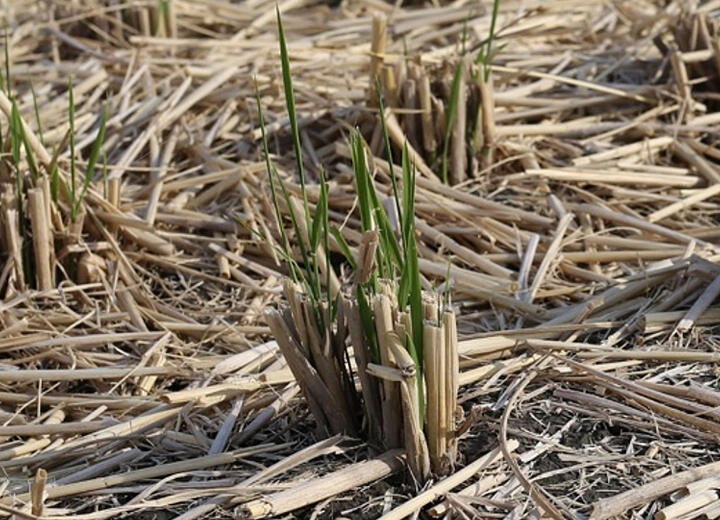A research group led by Deputy Leader Hiroshi Nakano of the Division of Crop Rotation Research for Lowland Farming at the Kyushu Okinawa Agricultural Research Center at the National Agriculture and Food Research Organization (NARO) (currently Senior Principal Scientist of the Central Region Agricultural Research Center at NARO) announced on October 4 that they have successfully developed a rice ratooning technique that produced rice at a record-breaking high yield in a test field in Fukuoka Prefecture. The rice variety used was the good-tasting, high-yielding 'Niji-no-Kirameki' cultivar. The total yield of the first and second crops averaged 944 kilograms (kg) per 10 ares over two years. The seedlings were transplanted in April, and the high cutting height of 40 centimeters (cm) in the first crop ensured that the starch and sugars accumulated in the stubble could be utilized and that regeneration would be vigorous. This technique is expected to be developed as a measure to prepare for future climate changes. The results were published in the international journal Crop Science.

Provided by NARO
Currently, in warmer regions such as Okinawa Prefecture, normal second crop rice cultivation with two transplanting and harvesting seasons is occasionally practiced. However, recent global warming has caused spring and fall temperatures to rise, resulting in the extension of the growing season of rice plants in other regions.
One method of rice cultivation that takes advantage of this is the rice ratooning technique, which involves regenerating sprouts (ratoons) from the stubble of the crop plant from the first harvest. Although rice ratooning requires water maintenance, the technique does not require the seedling raising and transplanting steps needed for a normal second crop rice cultivation. It is also expected to produce higher yields than a first crop.
Prior to this report, the research group had already developed a rice ratooning technique for an early-maturing line of a high-yielding rice varieties for animal feed. However, good-tasting rice varieties for export and commercial use had not been realized.
In this study, the research group aimed to develop a rice ratooning method for the 'Niji-no-Kirameki' cultivar. The cultivation of this rice variety has increased nationwide in recent years owing to its good taste, high yield, tolerance to high temperature and ripening, and disease resistance.
Based on the results of forage rice ratooning, yields were compared for the following four conditions: the transplanting time of the first crop (April and May planting) and the crop height at harvest in each season (high cutting at 40 cm or low cutting at 20 cm from the ground). Base and supplemental fertilizers were applied at 2−3 times the normal rate. Tests were conducted in 2021 and 2022 at NARO's test site in Chikugo City, Fukuoka Prefecture.
As a result, the total yield for the first and second crops was 9% higher for April planting than for May planting and 4% higher for high cutting than for low cutting. The 2-year average yield for April planting and high cutting was 944 kg per 10 ares. There was no significant difference in first-crop yield (∼600 kg) under either planting condition. By contrast, in the second crop, the April planting had a 49% higher yield than the May planting owing to a higher number of spikelets.
Next, nonstructural carbohydrates (NSCs), such as starch and sugars, and the photosynthesis-related leaf area index (LAI) of the first-crop stubble were examined for each planting condition. Previous studies had found that these factors were highly positively correlated with the number of spikelets in the second crop. NSCs can stimulate dormant sprouts on the stubble. The results showed that the NSCs and LAI of stubble from the April planting were increased relative to those from the May planting.
Investigation of the factors contributing to these increases in April planting showed that the time to first crop emergence was longer and the total plant body was larger, resulting in the increased stubble NSCs and LAI. The researchers speculated that the number of spikelets increased because the high cutting reserved more of them in the stubble than the low cutting, leading to an increase in yield. Additionally, there was no clear difference between the first season and second season in April planting in terms of the taste of the cooked rice.
Nakano stated, "This technology, which achieves record-breaking high yields, is expected to reduce the production cost per unit. However, it will be difficult to use a self-propelled combine harvester only for ear crops, such as wheat and rice. It will be necessary to use a standard combine harvester for a wide range of crops, such as soybeans and buckwheat, and to maintain water supply throughout the growing season, which also requires maintenance of soil fertility. We will keep these points in mind as we continue to develop technologies for different growing conditions for widespread use."
Journal Information
Publication: Crop Science
Title: Grain yield response to planting date and cutting height of the first crop in rice ratooning
DOI: 10.1002/csc2.21031
This article has been translated by JST with permission from The Science News Ltd. (https://sci-news.co.jp/). Unauthorized reproduction of the article and photographs is prohibited.




